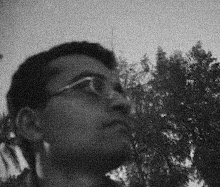25 year old lady was complaining of progressive diminution of vision since the last two years and had been investigated elsewhere with a plain CT scan one year back following referral by her ophthalmologist. She had completely lost her vision one year back during the last few months of pregnancy before the delivery of her first child. She has no other complaints.
On examination, she had no perception of light in either eye. Fundi had bilateral primary optic atrophy. There were no other deficits.
Plain CT scan [pvt film] showed a very ill defined small isodense suprasellar lesion. MRI showed a T1 isointense, T2 hyperintense lesion based on the tuberculum sellae stretching the optic nerve and chiasm. Lesion measured 3.0 X 2.6 X 2.3 cm. It was enchancing uniformly and brightly on Gad contrast. CT angiogram showed that the internal cerebral arteries and anterior cerebral arteries were stretched out but not encased by the lesion.
Since there was little possibility of recovery of vision even after microsurgical removal of the tumor in view of long standing total visual loss and established optic atrophy, she was strongly encouraged to consider the option of getting Gammaknife radiosurgery at concessional rate at another hospital. However, she and her husband chose to have microsurgery. She had developed phenytoin rash prior to surgery and anticonvulsant treatment was switched over to sodium valproate.
On 8/04/08 she underwent bifrontal craniotomy, sub frontal approach and complete excision of the lesion. [M.S. Gopalakrishnan, V.S. Hari, Balasubramanium] A sinusoidal bicoronal stealth incision was used for good cosmesis. An initial pterional transylvian approach had to be changed to bilateral subfrontal approach in view of technical (maneuvering) difficulties encountered with the available operating microscope. The lesion was firm and moderately vascular. A very small part of the lesion which was densely adherent to the left

Patient developed drowsiness on post operative day eight which improved with intensification of antiedema measures. Post op CT scan showed complete excision of the lesion. Bilateral basifrontal edema was present [retraction induced]. Pseudo-meningocele was aspirated and pressure dressing was given. At the time of discharge, she is afebrile, and well oriented. However she has increased talkativeness which may be due to mild frontal disinhibition due to frontal lobe retraction. This is expected to resolve.
Histopathology report is menigothelial meningioma [WHO grade 1]
Discussion:
The plain scan:







